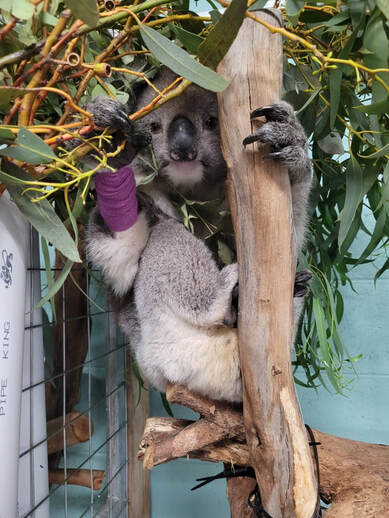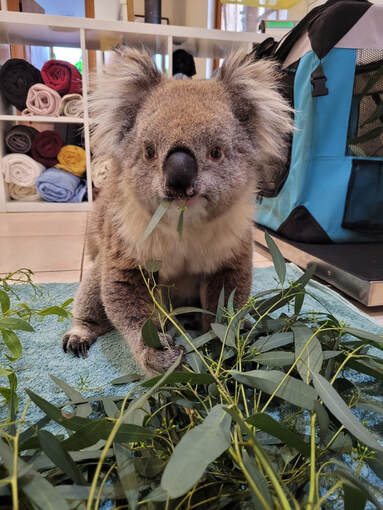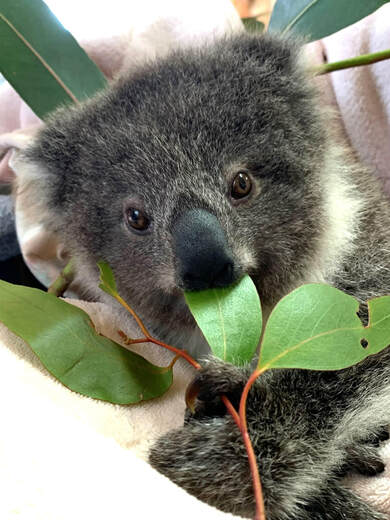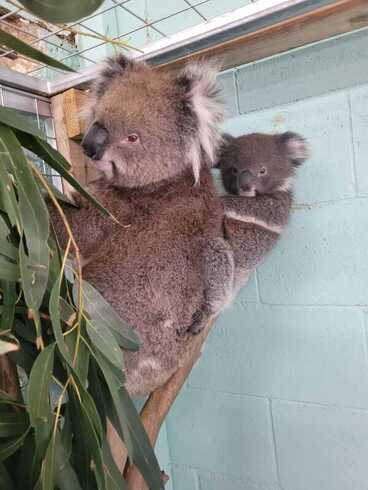10 Facts about Koalas you may not know
Koala Fact 1: Scientific Name
The scientific name for the koala is "Phascolarctos cinereus." This binomial nomenclature originates from the Greek words "phascolos," which means "pouch," and "arctos," which means "bear," even though koalas are not bears. The word "cinereus" in Latin translates to "ash-colored," referencing the koala's grey fur.
Koala Fact 2: Conservation Status - Endangered
The decision to list koalas as an endangered species on Australia’s east coast is a grim but important outcome that requires urgent action The ruling now categorizes koala populations in Queensland, New South Wales, and the Australian Capital Territory as "Endangered" according to the Environment Protection and Biodiversity Conservation Act (EPBC Act) of 1999. This classification acknowledges that koalas are closer to the brink of extinction. Without enhanced protective measures, koalas on the east coast face the dire possibility of vanishing entirely.
Koala Fact 3: Habitat & Distribution
Koalas are found primarily on the eastern coast of the continent. Their habitat predominantly spans from the northeastern state of Queensland, through New South Wales, down to the southeastern state of Victoria, and parts of South Australia.
Koalas are arboreal creatures, which means they spend a significant portion of their lives in trees. Their preferred environment is the eucalyptus forest or woodland because their diet consists almost entirely of eucalyptus leaves. Each individual koala requires a substantial amount of eucalyptus trees to sustain them, making habitat preservation critical for their survival.
However, over the last century, the distribution of koalas has reduced dramatically due to habitat loss from urban development, agriculture, and logging. Deforestation and fragmentation of their habitats have pushed koalas into smaller patches of suitable living space. Additionally, climate change poses another significant threat, altering the distribution and health of eucalyptus forests, further impacting koala populations. The preservation of their natural habitat is crucial for the survival and well-being of these iconic marsupials.
Koalas are arboreal creatures, which means they spend a significant portion of their lives in trees. Their preferred environment is the eucalyptus forest or woodland because their diet consists almost entirely of eucalyptus leaves. Each individual koala requires a substantial amount of eucalyptus trees to sustain them, making habitat preservation critical for their survival.
However, over the last century, the distribution of koalas has reduced dramatically due to habitat loss from urban development, agriculture, and logging. Deforestation and fragmentation of their habitats have pushed koalas into smaller patches of suitable living space. Additionally, climate change poses another significant threat, altering the distribution and health of eucalyptus forests, further impacting koala populations. The preservation of their natural habitat is crucial for the survival and well-being of these iconic marsupials.
Koala Fact 4: Difference between males and females
Male koalas typically overshadow their female peers in both size and weight, with males tipping the scales at approximately 50% heavier. This added bulk serves a purpose: it equips them for territorial skirmishes and vying for mating privileges.
A distinct feature in male koalas is a prominent chest gland, becoming more evident as they age. They utilize this gland to mark trees, delineating their territory and signaling their presence to fellow koalas. In contrast, females possess a less conspicuous chest gland.
While both genders of koalas vocalize — especially during mating seasons — males boast a deeper, more resonant bellow. These calls serve a dual role: beckoning potential mates and alerting competing males to tread carefully.
Koala Fact 5: Dietary Habits
Eucalyptus leaves form the staple of the koala diet, with koalas selectively feeding on around 30 out of over 600 eucalypt species. These leaves are not only a source of sustenance but also provide the majority of their water intake. Despite their abundance, eucalyptus leaves are not an easy food source. They are tough, fibrous, and contain chemical compounds that are toxic to most animals. Koalas, however, have evolved a suite of specialized adaptations to process these leaves. Their hindgut possesses an extended cecum and colon, allowing for prolonged fermentation of their hard-to-digest meals and efficient absorption of nutrients.
But this diet has its challenges. Eucalyptus leaves are low in protein and high in indigestible substances. This means koalas have to eat large quantities to meet their nutritional needs. Additionally, the energy yield from this diet is low, leading to the koala's sedentary lifestyle to conserve energy.
Need to know more? Then check out the page What do Koalas Eat? for loads more detailed information and facts
But this diet has its challenges. Eucalyptus leaves are low in protein and high in indigestible substances. This means koalas have to eat large quantities to meet their nutritional needs. Additionally, the energy yield from this diet is low, leading to the koala's sedentary lifestyle to conserve energy.
Need to know more? Then check out the page What do Koalas Eat? for loads more detailed information and facts
Koala Fact 6: Reproduction and lifecycle
Reproductively, koalas are seasonal breeders, with most mating occurring during the southern hemisphere's spring and summer. Females reach sexual maturity around 2 to 3 years, while males mature a bit later. The gestation period is relatively short, around 34-36 days. However, this is followed by a prolonged period of pouch life for the underdeveloped joey, which lasts about six months. Post-pouch life, the joey remains dependent on its mother, feeding on specialized fecal matter called "pap" that aids in the transition from milk to a eucalyptus diet.
Koala Fact 7: Diseases
Koalas, the iconic marsupials of Australia, face several health threats from various diseases that have grave implications for their survival.
The foremost among these is chlamydiosis, caused by the bacterium *Chlamydia pecorum*. Manifesting in different strains, it affects various body systems, leading to conditions like conjunctivitis, which can result in blindness. Additionally, the reproductive systems can be compromised, causing cystitis and infertility, particularly in females. The widespread nature of this infection makes it a primary concern for koala conservation.
Equally pressing is the Koala retrovirus (KoRV). While all koalas are believed to be born with it, its effects vary. It is postulated to weaken the koala's immune system, making them vulnerable to a range of diseases. Moreover, there's a strong association between KoRV and koala cancers, such as lymphoma and leukemia.
Oxalate nephrosis, a significant disease in koalas, affects their kidneys. Caused by high levels of oxalate crystals, it leads to renal failure. Environmental factors and diet changes may influence its prevalence, posing serious conservation concerns for this already vulnerable species.
Understanding these diseases is crucial, as their impacts, compounded by habitat loss and climate change, heighten the urgency of koala conservation efforts.
We see many koalas with a range of illnesses here at our Centre. Our free vet care is only possible with donations. Can you help us? Donate here.
The foremost among these is chlamydiosis, caused by the bacterium *Chlamydia pecorum*. Manifesting in different strains, it affects various body systems, leading to conditions like conjunctivitis, which can result in blindness. Additionally, the reproductive systems can be compromised, causing cystitis and infertility, particularly in females. The widespread nature of this infection makes it a primary concern for koala conservation.
Equally pressing is the Koala retrovirus (KoRV). While all koalas are believed to be born with it, its effects vary. It is postulated to weaken the koala's immune system, making them vulnerable to a range of diseases. Moreover, there's a strong association between KoRV and koala cancers, such as lymphoma and leukemia.
Oxalate nephrosis, a significant disease in koalas, affects their kidneys. Caused by high levels of oxalate crystals, it leads to renal failure. Environmental factors and diet changes may influence its prevalence, posing serious conservation concerns for this already vulnerable species.
Understanding these diseases is crucial, as their impacts, compounded by habitat loss and climate change, heighten the urgency of koala conservation efforts.
We see many koalas with a range of illnesses here at our Centre. Our free vet care is only possible with donations. Can you help us? Donate here.
Koala Fact 8: Sleeping habits
Ever watched a koala and thought it seemed a bit... drowsy? You're not alone! Koalas are renowned for their extensive sleeping habits, clocking in a whopping 18 to 20 hours of sleep daily. But contrary to a common myth, it's not because they're "drugged" or "tipsy" from eucalyptus leaves.
This lengthy sleep schedule is largely due to their unique diet of eucalyptus leaves. While these leaves are the mainstay of their diet, they are tough to digest and don't offer a lot of energy. So, after munching on their leafy meals, koalas need plenty of downtime to digest and conserve energy.
Most of their sleeping happens during the day, nestled snugly in the nooks and crannies of trees. If you ever come across a koala in the wild, there's a good chance you'll find it napping, curled into a cute ball, high up in a eucalyptus tree. So next time you're feeling a bit sleepy, just think: you're merely embracing your inner koala!
This lengthy sleep schedule is largely due to their unique diet of eucalyptus leaves. While these leaves are the mainstay of their diet, they are tough to digest and don't offer a lot of energy. So, after munching on their leafy meals, koalas need plenty of downtime to digest and conserve energy.
Most of their sleeping happens during the day, nestled snugly in the nooks and crannies of trees. If you ever come across a koala in the wild, there's a good chance you'll find it napping, curled into a cute ball, high up in a eucalyptus tree. So next time you're feeling a bit sleepy, just think: you're merely embracing your inner koala!
Koala Fact 9: Koala Fingerprints
Koalas hold an intriguing secret in their paws: fingerprints astonishingly similar to humans! In both structure and pattern, koala fingerprints can be nearly indistinguishable from those of people, even under a microscope. This shared characteristic is a curious case of convergent evolution, where two unrelated species develop similar features not due to shared ancestry but because of similar environmental demands. For koalas, these fingerprints likely aid in gripping and identifying different eucalyptus leaves, their primary diet. The resemblance is so pronounced that in a forensic setting, it might just cause a detective to do a double-take!
Koala Fact 10: Koalas aren’t bears
Koalas might look a bit like teddy bears, but they aren't bears at all! They're actually marsupials, like kangaroos and wallabies. The big giveaway? Koalas have a pouch where they carry and care for their babies, while real bears don't. So, while it might be tempting to call them "koala bears" because of their cute, cuddly appearance, it's not accurate. They're simply koalas, and they're unique in their own awesome way!
So now that you know these amazing facts, you have an opportunity to help their care by supporting our Centre and helping our mission to care for these unique creatures. There are so many ways you can help right now!
Donate directly - every dollar goes towards keeping this Centre operational and treating wildlife. It costs around $6000-7000 to do a full vet assessment and full diagnostic range of tests for every koala. You can make a difference - click here
Purchase from our online shop - all proceeds go to the Centre.






